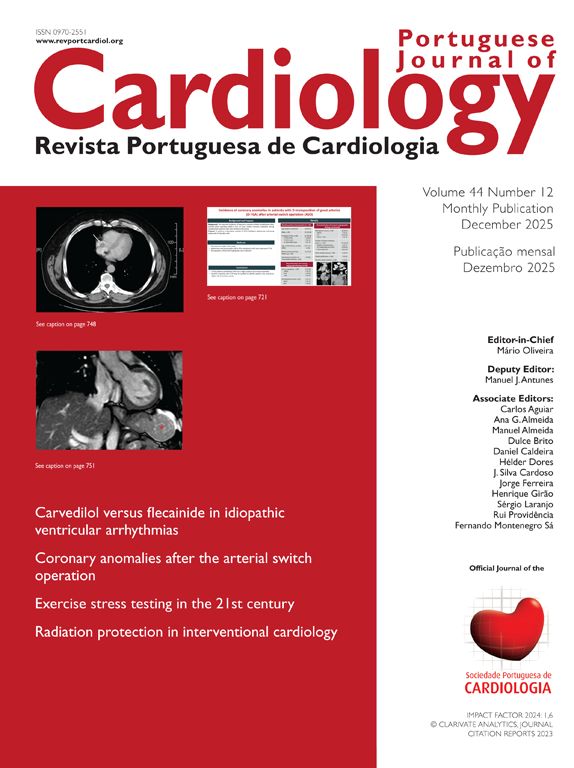Patients with acute coronary syndrome (ACS) are a heterogeneous population in terms of both diagnosis and prognosis, and therefore risk stratification is an essential element in the therapeutic approach.1 In non-ST-elevation ACS (NSTE-ACS), early identification of patients at high ischemic risk enables immediate measures to be taken that have a positive impact on outcome, such as an invasive strategy to assess coronary anatomy with a view to revascularization.
Risk stratification at the time of initial diagnostic assessment is a class I recommendation, level of evidence A, in the guidelines for NSTE-ACS from both the European Society of Cardiology and the American College of Cardiology/American Heart Association.1,2 Stratification is based on clinical and demographic variables, the electrocardiogram (ECG), and laboratory tests. Older age, diabetes, renal dysfunction, hemodynamic instability, signs of heart failure, ischemic changes on the ECG and elevated biomarkers of myocardial necrosis, inflammation and neurohormonal activation are all indicators of worse prognosis. Risk scores, which combine and integrate these variables, improve the accuracy of ischemic risk stratification and thus prediction of cardiovascular events.3 The GRACE score has the best performance in quantifying ischemic risk at admission and in selecting patients for revascularization.1,3
However, even patients initially classified as low risk may have a complicated clinical course, and identification of these individuals is a challenge for ongoing risk stratification. The development of signs of heart failure after admission, or detection of dynamic ischemic ST-segment changes on continuous ECG monitoring or of left ventricular dysfunction, will significantly change the level of risk in a patient initially classified as low or intermediate risk.4,5 This is also the case for patients who are subsequently found to have severe coronary artery disease (CAD) on coronary angiography, including left main and/or three-vessel disease (LM/3VD).6
In this issue of the Journal, Carvalho et al. assess the prevalence, clinical outcomes and predictors of LM/3VD in patients included in the Portuguese Registry of Acute Coronary Syndromes and classified as low risk on admission on the basis of a GRACE score of ≤108.7 These accounted for around 20% of all patients with NSTE-ACS in the registry, which is a slightly lower figure than in another Portuguese study.3 Coronary angiography identified LM/3VD in 18% of low-risk patients, meaning that 3.5% of patients with NSTE-ACS classified as low risk had severe CAD. Not surprisingly, the prevalence of severe CAD in such low-risk patients is much lower than that reported in observational studies.8
In the study by Carvalho et al., LM/3VD was associated with higher mortality (0.9% vs. 0.0%), more major adverse cardiac and cerebrovascular events (4.1% vs. 2.5%), and higher one-year mortality (2.4% vs. 0.5%) than in those without LM/3VD. However, these differences did not reach statistical significance, which may in part be due to the fact that most patients underwent coronary angiography within 24 hours of admission, and therefore early revascularization following detection of LM/3VD may have reduced the absolute risk associated with severe CAD.
The independent predictors of LM/3VD identified by the authors were age (OR 1.03; 95% confidence interval [CI] 1.01–1.05, p=0.003 for each 10-year increase in age), male gender (OR 2.56; 95% CI 1.56–4.17, p<0.001), heart rate (1.02; 95% CI 1.01–1.03, p<0.001 for each 10-bpm increase in heart rate), and previous peripheral arterial disease (OR 3.21; 95% CI 1.47–7.00, p<0.001) and heart failure (OR 3.38; 95% CI 1.02–11.15, p=0.046). It is interesting to note that age and heart rate are among the variables of the GRACE score, which identified these patients as low risk. This apparent paradox may be related to the fact that both these variables are numerical, which affects continuous risk. Otherwise, the performance of the GRACE score was adequate, since the absolute risk of in-hospital death in patients with LM/3VD (<1%) was within the range estimated by the score for low-risk patients.9 Previous heart failure and peripheral arterial disease are also risk markers in ACS and are commonly associated with more severe CAD.8
However, the presence of any of these predictors of CAD severity will be unlikely to prompt selection of the patient for early coronary angiography, since in daily clinical practice it is low-risk patients who more often undergo an invasive strategy. This reversal of a risk-guided therapeutic approach has in fact been observed in a range of studies, including the GRACE registry, in which angiography was performed in 72% of low-risk patients, 68% of intermediate-risk patients and only 51% of high-risk patients.10 This is a problem that needs to be addressed. Risk stratification should be carried out in all NSTE-ACS patients with a view to referring those at highest risk for coronary angiography, as stipulated in the guidelines.1,2
Conflicts of interestThe author has no conflicts of interest to declare.
Please cite this article as: Ferreira J. Estratificação de risco nas síndromes coronárias agudas: quando o menos vale mais. Rev Port Cardiol. 2018;37:921–922.





